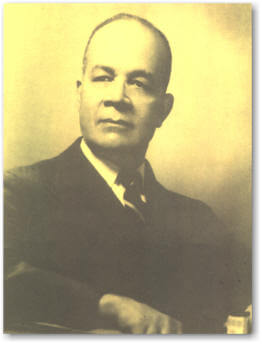
Joel Augustus Rogers
(1883 to 1966)
Joel Augustus Rogers
was born September 6, 1883 at Negril,
Jamaica. Very little is known about his early schooling. The historian is said
to have had a "good basic education" but lacked higher formal education.
J.A.
Rogers immigrated to the United States in 1906 and became a naturalized citizen
in 1917. Despite his light complexion and mulatto background, Rogers bitterly
discovered that Black people were all treated the same, no matter the
complexion. Rogers, however, rejected the dogma of white superiority, even as a
child. In a class and color conscious Jamaica, the young Rogers observed, "I had
noticed that some of my schoolmates were unmixed blacks and were, some of them,
more brilliant than some of the white ones." Rogers grew up around Blacks who
were physicians and lawyers--graduates of "the best English and Scottish
Universities." This realization that the doctrine of white superiority was
contradicted by the talent and expertise of Black intellect inspired Rogers to
begin his research into the Black experience.
J.A.
Rogers' search for truth led him to examine the African blood lines of Europeans
and Americans. His signal work, "Nature Knows No Color-Line" and the
three-volume set, "Sex and Race" destroyed the myth of Aryan race purity.
Rogers' other historical focus was on producing biographical portraits of
prominent African personages. In 1931, he published "The World's Greatest Men of
African Descent" and in 1947, published "The World's Great Men of Color 3000
B.C. to 1946 A.D." Joel Augustus Rogers died on his birthday, September 6, 1966.
bio. written by by
Runoko Rashidi
 Your History: From Beginning of Time to the Present
Your History: From Beginning of Time to the PresentClick to order Directly from Black Classic Press or Amazon
Paperback: 100 pages
Publisher: Black Classic Press; Facsim.of 1940 Ed edition (June 1, 1983)
Language: English
ISBN-10: 0933121040
ISBN-13: 978-0933121041
Product Dimensions: 10.7 x 8.2 x 0.3 inches
First published in 1940 and brought back into print by Black Classic Press in 1983, Your History commemorated the centennial anniversary of Rogers' birth.
Rogers, a self-taught historian, would write columns which were published weekly in Black newspapers across America and read by hundreds of thousands of Blacks.
Sample page from Your History: From Beginning of Time to the Present
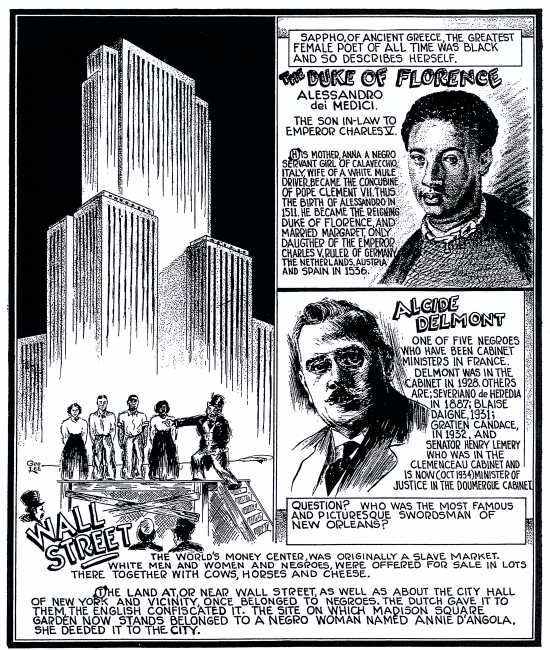
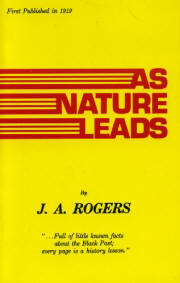 As
Nature Leads
As
Nature LeadsClick to order Directly from Black Classic Press or Amazon
Paperback: 207 pages
Publisher: Black Classic Press (March 1, 1987)
Language: English
ISBN-10: 0933121156
ISBN-13: 978-0933121157
Product Dimensions: 8.3 x 5.4 x 0.7 inches
First published in 1919, Rogers focuses on the seldom discussed topic of Black "blood" in the white race. By exposing the extensive intermixture and intermarriage of Blacks and whites, Rogers attacks racist thought at its roots.
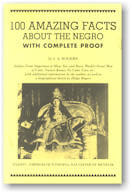 100 Amazing Facts about
the Negro with Complete Proof
100 Amazing Facts about
the Negro with Complete ProofClick to order via Amazon
ISBN: 0960229477
Format: Paperback, 71pp
Pub. Date: January 1989 (originally published in 1934)
Publisher: Helga Rogers
Edition Description: REVISED
Written in the 1940's and published in 1957.
Example:
BLACK FACT:
White American slave-holders used to induce white women to marry Negro slaves in order to hold the women slaves for life.
PROOF:
In Sept. 1664, Maryland passed a law that any white woman who married a 'Negro' should serve the master of such slave "for life." Slave-holders took advantage of this law to induce the white women, some of whom were recent arrivals, to marry the "Negroes." MacCormac says, "Instead of preventing such marriages this law enabled avaricious and unprincipled masters to convert many of their (white) servants into slaves." In 1681, the Legislature was forced to issue the following law: "Divers freeborn English or white women sometimes by the instigation, procurement, and connivance of their master.... and always to the satisfaction of their lascivious and lustful desires....do intermarry with 'Negroes' and other slaves, be it enacted that if any master....having any freeborn English or white woman servant in their possession or property, shall by any instigation, procurement, knowledge, permission or contrivance," cause her to marry a slave she should be free at once and the master should pay a fine of "10,000 lbs. of tobacco." (Archives of Maryland, Vol. I, pp. 433-34; and Vol. III, pp. 203-04, also Johns Hopkins University Studies in Hist. & Pol. Science, No. 3 & 4.) What is true of Maryland was true of other states.
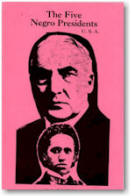 Five Negro
Presidents Five Negro
PresidentsClick to order via Amazon Binding: Paperback ISBN: 0960229485 Number Of Pages: 19 Publication Date: May 01, 1965 Publisher: Helga M. Rogers |
 Sex and Race:
Negro-Caucasian Mixing in All Ages and All Lands : The Old World Sex and Race:
Negro-Caucasian Mixing in All Ages and All Lands : The Old WorldClick to order via Amazon Hardcover: 302 pages Publisher: Helga M. Rogers (June 15, 1970) Language: English ISBN-10: 096022940X ISBN-13: 978-0960229406 Product Dimensions: 9.1 x 6.3 x 0.9 inches |
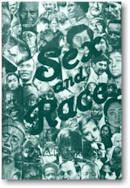 Sex and Race: A History of
White, Negro, and Indian Miscegenation in the Two Americas Vol, 2
Sex and Race: A History of
White, Negro, and Indian Miscegenation in the Two Americas Vol, 2Click to order via Amazon
ISBN: 0960229418
Format: Hardcover, 304pp
Pub. Date: January 1989
Publisher: Helga Rogers
Sex and Race was published in three volumes from 1941 to 1944. The first volume focuses on antiquity and is arguably the most fundamental of the three. As to ancient Asia, for example, Rogers devoted several pages of Sex and Race to the Black presence in early Japan. In the process he cites the studies of a number of accomplished scholars and anthropologists, raising the question "were the first Japanese Negroes?"
Other chapters are devoted to "The Negro in Ancient Greece," "Negroes in Ancient Rome and Carthage" and "Were the Jews Originally Negroes?" The appendices of Sex and Race are equally fascinating, focusing on "Black Gods and Messiahs" and the "History of the Black Madonnas." In Volume Two of Sex and Race Rogers examines "racism and race-mixing in the New World," while Volume Three of Sex and Race seeks to define the concept of race itself. Like most of his works, all three volumes of Sex and Race are lavishly illustrated. 'Runoko Rashidi
|
Sex and Race: The Old World, Vol. 1 Click to order via Amazon ISBN: 096022940X Format: Hardcover, 411pp Pub. Date: December 1990 Publisher: Helga Rogers |
Sex and Race: Why White and Black Do Mate, Vol. 3 Click to order via AmazonISBN: 0960229426 Format: Hardcover, 359pp Pub. Date: November 1990 Publisher: Helga Rogers |
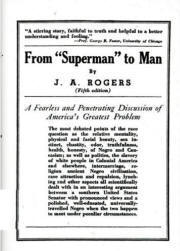 From
"Superman" to Man
From
"Superman" to ManClick to order via Amazon
by Joel Augustus Rogers
ISBN: 0960229442
Format: Hardcover, 132pp
Pub. Date: January 1989
Publisher: Helga Rogers
This short book follows a prolonged conversation on skin color prejudice between a white senator from the South and his widely traveled, well-read Black porter. Rogers himself worked as a Chicago porter and was largely self-educated. Toward the end of the book, Dixon, the porter, is asked if Christianity has not been a solace to mistreated Black people. Dixon echoes the feelings of his creator:
To enslave a man, then dope him to make him content! Do you call THAT a solace? . . . The honest fact is that the greatest hindrance to the progress of the Negro is that same dope that was shot into him during slavery. . . . The slogan of the Negro devotee is: Take the world but give me Jesus, and the white man strikes an eager bargain with him. . . . Another fact ' there are far too many Negro preachers. Religion is the most fruitful medium for exploiting this already exploited group. As I said, the majority of the sharpers, who among the whites would go into other fields, go, in this case, to the ministry.'John Ragland (http://www.atheists.org/Atheism/roots/ham)
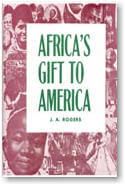 Africa's Gift to America:
The Afro-American in the Making and Saving of the United States : With New
Supplement, Africa and Its Potentialities
Africa's Gift to America:
The Afro-American in the Making and Saving of the United States : With New
Supplement, Africa and Its PotentialitiesClick to order via Amazon
ISBN: 0960229469
Format: Hardcover, 272pp
Pub. Date: January 1989
Publisher: Helga Rogers
Edition Description: REVISED
Africa's Gift to America is another classic which should be added to the library of every serious student of African American history. He lays out in clear and fascinating detail the role of the African American from the founding of the nation in the 17th century through the Revolutionary War period to the Civil War and early Post-Civil War era. His use of first hand documents such as newspapers, magazines, political cartoons, journals, and his extensive citation to then-contemporary historical works is masterfully woven to create a rich historical tapestry. His mentioning of obscure historical facts such as the Corwin Amendment, the rejected original form of the 13th Amendment that would have preserved rather than abolished slavery, as well as the role of slave Jo Anderson in creating the McCormick reaper, are but a small sampling of the treasures within this invaluable volume.
Related links
Hitler and the Negro by J. A. Rodgers
http://www.nathanielturner.com/hitlerandnegro.htm
*******************************************
Joel Augustus Rogers (September 6, 1880 – March 26, 1966) was a Jamaican-American author, journalist, and historian who contributed to the history of Africa and the African diaspora, especially the history of African Americans
in the United States. His research spanned the academic fields of
history, sociology and anthropology. He challenged prevailing ideas
about race, demonstrated the connections between civilizations, and
traced African achievements. He was one of the greatest popularizers of
African history in the 20th century.
Early life and education
Joel Augustus Rogers was born 6 September 1880 (some sources say 1883) in Negril, Jamaica. One of eleven children, he was the son of mixed-race parents who were a minister and schoolteacher. His parents were only able to afford to give Rogers and his ten siblings a rudimentary education, but stressed the importance of learning. Rogers himself claimed to have had a "good basic education". Some sources implied that he became an autodidact later in life.Emigration and career
Rogers emigrated from Jamaica to the United States in 1906, where he settled in Harlem, New York. There he lived most of his life. He was there during the Harlem Renaissance, a flowering of African-American artistic and intellectual life in numerous fields. Rogers became a close personal friend of the Harlem-based intellectual and activist Hubert Harrison.While living in Chicago for a time in the 1920s, Rogers worked as a Pullman porter and as a reporter for the Chicago Enterprise. His job of Pullman porter allowed Rogers to travel and observe a wide range of people. Through this travel, Rogers was able to feed his appetite for knowledge, by using various libraries in the cities which he visited. Rogers self-published the results of his research in several books.
From "Superman" to Man
Rogers' first book From "Superman" to Man, self-published in 1917, attacked notions of African inferiority. From "Superman" to Man is a polemic against the ignorance that fuels racism. Its title is a twist on contemporary works, both George Bernard Shaw’s Man and Superman and Nietzsche’s idea of the "Superman." The central plot revolves around a debate between a Pullman porter and a white racist Southern politician. Rogers used this debate to air many of his personal philosophies and to debunk stereotypes about black people and white racial superiority. The porter’s arguments and theories are pulled from a plethora of sources, classical and contemporary, and run the gamut from history and anthropology to biology. Many of the ideas that permeated Rogers’ later work can be seen germinating in From "Superman" to Man. Rogers addresses issues such as the lack of scientific support for the idea of race, black historical vindicationism, and the fact of intermarriage and unions among peoples throughout history.Newspaper career
In the 1920s Rogers worked as a journalist on the Pittsburgh Courier and the Chicago Enterprise. He was a sub-editor of Marcus Garvey's short-lived Daily Negro Times. As a newspaper correspondent, he covered such events as the coronation of Emperor Haile Selassie I of Ethiopia for the New York Amsterdam News. He wrote for a variety of black newspapers and journals: Crisis, American Mercury, The Messenger Magazine, the Negro World and Survey Graphic. One of his interviews was with Marcus Garvey in prison (New York Amsterdam News, 17 November 1926).Rogers served as the only black US war correspondent during World War II.
Rogers also contributed the writing to a syndicated newspaper cartoon feature titled Your History. Patterned after the look of Robert Ripley's popular Believe It or Not cartoons, multiple vignettes in each cartoon episode recounted short items from Rogers' research. The feature began in the Pittsburgh Courier in November 1934, with art by George L. Lee. In 1940 the art chores were handed over to Samuel Milai, who stayed with the feature through the rest of its run. In 1962, the title was changed to Facts About The Negro. The feature outlived its author, and continued appearing regularly until 1971, presumably in reprints at the end of the run. Two collections were published, Your History in 1940 and Facts About The Negro c. 1960.
Other works
Rogers’ work was concerned with "the Great Black Man" theory of history. This theory presented history, specifically black history, as a mural of achievements by prominent black people. Rogers devoted a significant amount of his professional life to unearthing facts about people of African ancestry. He intended these findings to be a refutation of contemporary racist beliefs about the inferiority of blacks. Books such as 100 Amazing Facts about the Negro, Sex and Race, and World’s Great Men of Color, all described remarkable black people throughout the ages and cited significant achievements of black people.Rogers commented on the partial black ancestry of some prominent Europeans, including Alexander Pushkin and Alexandre Dumas, père. Similarly, Rogers was among those who asserted that a direct ancestor of the British royal family, Charlotte of Mecklenburg-Strelitz, had a remote ancestor who was of African origin.
Rogers’ theories about race, sex and color can be found in the books Nature Knows No Color-Line, World’s Great Men of Color and the pamphlet Five Negro Presidents, all of which deal with the ideas of race, sex and color. In the latter, he provided what he said was evidence that there had been 19th and 20th century presidents of the United States who had partial black ancestry.
Rogers surmised that a large percentage of ethnic differences were the result of sociological factors. However, in Rogers’ opinion, often the differences between groups were attributed primarily to physical differences such as race. Rogers deals with the themes of race and sex in the eponymous Sex and Race and also in Nature Knows No Color-Line. Rogers’ research in these works was directed to examining miscegenation and how that has left a black "strain" in Europe and the Americas.
In Nature Knows No Color-Line, Rogers examined the origins of racial hierarchy and the color problem. Rogers stated that the origins of the race problem had never been adequately examined or discussed. Rogers believed that color prejudice generally evolved from issues of domination and power between two physiologically different groups. According to Rogers, color prejudice was then used a rationale for domination, subjugation and warfare. Societies developed myths and prejudices in order to pursue their own interests at the expense of other groups. Rogers was trying to show that there is nothing innate about color prejudice; that there is no natural distaste for darker skin by lighter-skinned people; and that there is no natural aversion for lighter skin by darker-skinned people.
Within these works, Rogers questioned the concept of race, the origins of racial differentiation, and the root of the "color problem." Rogers felt that the "color problem" was that race was used as social, political and economic determining factors.
Philosophy and viewpoint
Rogers was a meticulous researcher, astute scholar and concise writer.[citation needed] He traveled tirelessly on his quest for knowledge, which often took him directly to the source. While traveling in Europe, he frequented libraries, museums, and castles, finding sources that helped him prove African ancestry and history. He challenged the biased viewpoint of Eurocentric historians and anthropologists.Rogers gathered what he called "the bran of history". The bran of history was the uncollected, unexamined history of the world, and his interest was the history of black people. Rogers intended that the neglected parts of history would become part of the mainstream body of Western history. He saw black inclusion in white historical discourses as helping to bridge racial divides. His scholarship was meant to shed light on hitherto unexamined areas of Africana history. This historical goal made Rogers a vindicationist scholar, attempting to combat the stereotypes of inferiority that were attributed to black people.
Rogers asserted that the color of skin did not determine intellectual genius, and that Africans had contributed more to the world than was previously acknowledged. He publicized the great black civilizations that had flourished in Africa during antiquity. He devoted his scholarship to vindicating a place for African people within Western history. According to Rogers, many ancient African civilizations had been primal molders of Western civilization and culture.
With these assertions, Rogers was attempting to point out the absurdity of racial divisions. Rogers' belief in one race - humanity - precluded the idea of several different ethnic races. In this, Rogers was a humanist. Rogers used vindicationist history as a tool to bolster his ideas about humanism. Rogers used his scholarship to prove his underlying humanistic thesis: that people were one large family without racial boundaries.
Rogers was self-financed, self-educated, and self-published. Some critics have focused on Rogers' lack of a formal education as a hindrance to producing scholarly work; others suggested Rogers' autodidacticism freed him from many academic and methodological restrictions. He made himself free to tackle the difficult racial issues with which he dealt. As an autodidact, Rogers followed his research into various disciplines that more formally educated scholars may have been loath to attempt. His works are complete with detailed references. That he documented his work to encourage scrutiny of his facts was a testament to his due diligence, work ethic and commitment to not only African people, but the world, its history and culture.
Rogers articulated ideas about race that were informed by anthropology and biology, rather than social convention. He used vindicationism not as end in itself, but as a tool to underscore his humanist beliefs, and to illustrate the unity of humanity as a people. He discarded the non-scientific definition of race and pursued his own ideas about humanity’s interconnectedness. Thus, although the work of Rogers has often been relegated to the controversial genre of Afrocentric history, his main contribution to African scholarship was his nuanced analysis of the concept of race.
Rogers was an atheist, opining in From "Superman" to Man that Christianity, and religion in general, were nothing more than dope used by Caucasians to exploit Negroes.
[edit] Legacy and honors
Rogers was a member of professional associations such as the Paris Society of Anthropology, the American Geographical Society, the American Association for the Advancement of Science, and the Academy of Political Science.Rogers, in the words of Dr. John Henrik Clarke, "looked at the history of people of African origin, and showed how their history is an inseparable part of the history of mankind."
Joel Augustus Rogers died in New York on March 26, 1966 in New York City. He was survived by his wife Helga M. Rogers.
Works
- From "Superman" to Man. Chicago: J. A. Rogers, 1917. —novel.
- As Nature Leads: An Informal Discussion of the Reason Why Negro and Caucasian are Mixing in Spite of Opposition. Chicago: M. A. Donahue & Co, 1919. —novel.
- The Approaching Storm and Bow it May be Averted: An Open Letter to Congress Chicago: National Equal Rights League, Chicago Branch: 1920.
- "Music and Poetry — The Noblest Arts," Music and Poetry, vol. 1, no. 1 (January 1921).
- "The Thrilling Story of The Maroons," serialized in The Negro World, March–April, 1922.
- "The West Indies: Their Political, Social, and Economic Condition," serialized in The Messenger (Volume 4, Number 9, September, 1922).
- Blood Money (Novel) serialized in New York Amsterdam News, April 1923.
- "The Ku Klux Klan A Menace or A Promise," serialized in The Messenger (Volume 5, Number 3, March, 1923).
- "Jazz at Home" The Survey Graphic Harlem, vol. 6, no. 6 ( March 1925).
- "What Are We, Negroes or Americans?" The Messenger, vol. 8, no. 8 (August, 1926).
- Book Review, Jazz, by Paul Whiteman." Opportunity: The Journal of Negro Life (Volume 4, Number 48, December, 1926).
- "The Negro's Experience of Christianity and Islam," Review of Nations, Geneva (January–March 1928)
- "The American Occupation of Haiti: Its Moral and Economic Benefit," by Dantes Bellegarde. (Translator). Opportunity: Journal of Negro Life (Volume 8, Number 1, January, 1930).
- "The Negro in Europe," The American Mercury (May 1930).
- "The Negro in European History," Opportunity: Journal of Negro Life (Volume 8, Number 6, June 1930).
- World's Greatest Men of African Descent. New York: J. A. Rogers Publications, 1931.
- "The Americans in Ethiopia," under the pseudonym Jerrold Robbins, in American Mercury (May 1930).
- "Enrique Diaz," in Opportunity: Journal of Negro Life, vol. 11, no. 6 (June 1933).
- 100 Amazing facts about the Negro with Complete Proof. A Short Cut to the World History of the Negro. New York: J. A. Rogers Publications, 1934.
- World's Greatest Men and Women of African Descent. New York: J. A. Rogers Publications, 1935.
- "Italy Over Abyssinia," The Crisis, Volume 42, Number 2, February 1935.
- The Real Facts About Ethiopia. New York: J.A Rogers, 1936.
- "When I Was In Europe," Interracial Review: A journal for Christian Democracy, October, 1938.
- "Hitler and the Negro," Interracial Review: A Journal for Christian Democracy, April, 1940.
- "The Suppression of Negro History," The Crisis, vol. 47, no. 5 (May 1940).
- Your History: From the Beginning of Time to the Present. Pittsburgh: Pittsburgh Courier Publishing Co, 1940.
- An Appeal From Pioneer Negroes of the World, Inc: An Open Letter to His Holiness Pope Pius XII. New York: J. A. Rogers, 1940.
- Sex and Race: Negro-Caucasian Mixing in All Ages and All Lands, Volume I: The Old World. New York: J. A. Rogers, 1941.
- Sex and Race: A History of White, Negro, and Indian Miscegenation in the Two Americas, Volume II: The New World. New York: J. A. Rogers, 1942.
- Sex and Race, Volume III: Why White and Black Mix in Spite of Opposition. New York: J. A. Rogers, 1944.
- World's Great Men of Color, Volume I: Asia and Africa, and Historical Figures Before Christ, Including Aesop, Hannibal, Cleopatra, Zenobia, Askia the Great, and Many Others. New York :J. A. Rogers, 1946.
- World's Great Men of Color, Volume II: Europe, South and Central America, the West Indies, and the United States, Including Alessandro de' Medici, Alexandre Dumas, Dom Pedro II, Marcus Garvey, and Many Others (New York: J. A. Rogers, 1947).
- "Jim Crow Hunt," The Crisis (November 1951).
- Nature Knows No Color Line: Research into the Negro Ancestry in the White Race. (New York: J. A. Rogers, 1952).
- Facts About the Negro. (Drawings by A. S. Milai) (booklet) (Pittsburgh: Lincoln Park Studios, 1960).
- Africa's Gift to America: The Afro-American in the Making and Saving of the United States. With New Supplement Africa and its Potentialities. (New York: J. A. Rogers, 1961).
- She Walks in Beauty. Los Angeles: Western Publishers, 1963. —novel
- "Civil War Centennial: Myth and Reality," Freedomways, vol. 3, no.1 (Winter 1963).
- The Five Negro Presidents: According to What White People Said They Were. New York: J. A. Rogers, 1965.
No comments:
Post a Comment